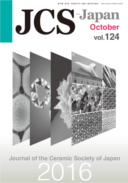124 巻, 10 号
(October)
選択された号の論文の43件中1~43を表示しています
- |<
- <
- 1
- >
- >|
-
2016 年 124 巻 10 号 p. H10-1
発行日: 2016年
公開日: 2016/10/01
PDF形式でダウンロード (854K) -
2016 年 124 巻 10 号 p. C10-1-C10-6
発行日: 2016年
公開日: 2016/10/01
PDF形式でダウンロード (2452K)
Feature: Molecular Synthesis Routes towards Advanced Ceramics: Preface
-
2016 年 124 巻 10 号 p. P10-1-P10-3
発行日: 2016年
公開日: 2016/10/01
PDF形式でダウンロード (82K)
Feature: Molecular Synthesis Routes towards Advanced Ceramics: Review
-
2016 年 124 巻 10 号 p. 967-980
発行日: 2016/10/01
公開日: 2016/10/01
PDF形式でダウンロード (3469K)
Feature: Molecular Synthesis Routes towards Advanced Ceramics: Full papers
-
2016 年 124 巻 10 号 p. 981-988
発行日: 2016/10/01
公開日: 2016/10/01
PDF形式でダウンロード (3899K) -
2016 年 124 巻 10 号 p. 989-995
発行日: 2016/10/01
公開日: 2016/10/01
PDF形式でダウンロード (655K) -
2016 年 124 巻 10 号 p. 996-1002
発行日: 2016/10/01
公開日: 2016/10/01
PDF形式でダウンロード (5777K) -
2016 年 124 巻 10 号 p. 1003-1005
発行日: 2016/10/01
公開日: 2016/10/01
PDF形式でダウンロード (803K) -
2016 年 124 巻 10 号 p. 1006-1012
発行日: 2016/10/01
公開日: 2016/10/01
PDF形式でダウンロード (5791K) -
2016 年 124 巻 10 号 p. 1013-1016
発行日: 2016/10/01
公開日: 2016/10/01
PDF形式でダウンロード (2250K) -
2016 年 124 巻 10 号 p. 1017-1022
発行日: 2016/10/01
公開日: 2016/10/01
PDF形式でダウンロード (3070K) -
2016 年 124 巻 10 号 p. 1023-1029
発行日: 2016/10/01
公開日: 2016/10/01
PDF形式でダウンロード (4820K) -
2016 年 124 巻 10 号 p. 1030-1034
発行日: 2016/10/01
公開日: 2016/10/01
PDF形式でダウンロード (1065K) -
2016 年 124 巻 10 号 p. 1035-1041
発行日: 2016/10/01
公開日: 2016/10/01
PDF形式でダウンロード (15392K) -
2016 年 124 巻 10 号 p. 1042-1045
発行日: 2016/10/01
公開日: 2016/10/01
PDF形式でダウンロード (1498K) -
2016 年 124 巻 10 号 p. 1046-1051
発行日: 2016/10/01
公開日: 2016/10/01
PDF形式でダウンロード (3447K) -
2016 年 124 巻 10 号 p. 1052-1055
発行日: 2016/10/01
公開日: 2016/10/01
PDF形式でダウンロード (2645K) -
2016 年 124 巻 10 号 p. 1056-1062
発行日: 2016/10/01
公開日: 2016/10/01
PDF形式でダウンロード (2804K) -
2016 年 124 巻 10 号 p. 1063-1066
発行日: 2016/10/01
公開日: 2016/10/01
PDF形式でダウンロード (663K) -
2016 年 124 巻 10 号 p. 1067-1071
発行日: 2016/10/01
公開日: 2016/10/01
PDF形式でダウンロード (2992K) -
2016 年 124 巻 10 号 p. 1072-1082
発行日: 2016/10/01
公開日: 2016/10/01
PDF形式でダウンロード (1075K) -
2016 年 124 巻 10 号 p. 1083-1089
発行日: 2016/10/01
公開日: 2016/10/01
PDF形式でダウンロード (1131K)
Feature: Molecular Synthesis Routes towards Advanced Ceramics: Notes
-
2016 年 124 巻 10 号 p. 1090-1093
発行日: 2016/10/01
公開日: 2016/10/01
PDF形式でダウンロード (1575K) -
2016 年 124 巻 10 号 p. 1094-1099
発行日: 2016/10/01
公開日: 2016/10/01
PDF形式でダウンロード (1871K)
Regular Articles: Special Articles: The 70th CerSJ Awards for Academic Achievements in Ceramic Science and Technology: Review
-
2016 年 124 巻 10 号 p. 1100-1109
発行日: 2016/10/01
公開日: 2016/10/01
PDF形式でダウンロード (4259K) -
2016 年 124 巻 10 号 p. 1110-1115
発行日: 2016/10/01
公開日: 2016/10/01
PDF形式でダウンロード (2126K)
Regular Articles: Full papers
-
2016 年 124 巻 10 号 p. 1116-1122
発行日: 2016/10/01
公開日: 2016/10/01
PDF形式でダウンロード (5939K) -
2016 年 124 巻 10 号 p. 1123-1126
発行日: 2016/10/01
公開日: 2016/10/01
PDF形式でダウンロード (3028K) -
2016 年 124 巻 10 号 p. 1127-1131
発行日: 2016/10/01
公開日: 2016/10/01
PDF形式でダウンロード (2039K) -
2016 年 124 巻 10 号 p. 1132-1140
発行日: 2016/10/01
公開日: 2016/10/01
PDF形式でダウンロード (2207K) -
2016 年 124 巻 10 号 p. 1141-1145
発行日: 2016/10/01
公開日: 2016/10/01
PDF形式でダウンロード (784K) -
2016 年 124 巻 10 号 p. 1146-1151
発行日: 2016/10/01
公開日: 2016/10/01
PDF形式でダウンロード (2668K) -
2016 年 124 巻 10 号 p. 1152-1156
発行日: 2016/10/01
公開日: 2016/10/01
PDF形式でダウンロード (3324K) -
2016 年 124 巻 10 号 p. 1157-1160
発行日: 2016/10/01
公開日: 2016/10/01
PDF形式でダウンロード (4041K)
Regular Articles: Notes
-
2016 年 124 巻 10 号 p. 1161-1163
発行日: 2016/10/01
公開日: 2016/10/01
PDF形式でダウンロード (2131K) -
2016 年 124 巻 10 号 p. 1164-1166
発行日: 2016/10/01
公開日: 2016/10/01
PDF形式でダウンロード (1053K) -
2016 年 124 巻 10 号 p. 1167-1170
発行日: 2016/10/01
公開日: 2016/10/01
PDF形式でダウンロード (1338K)
Announcements
-
2016 年 124 巻 10 号 p. A10-1-A10-2
発行日: 2016年
公開日: 2016/10/01
PDF形式でダウンロード (17K) -
2016 年 124 巻 10 号 p. A10-3-A10-4
発行日: 2016年
公開日: 2016/10/01
PDF形式でダウンロード (89K) -
2016 年 124 巻 10 号 p. A10-5
発行日: 2016年
公開日: 2016/10/01
PDF形式でダウンロード (55K) -
2016 年 124 巻 10 号 p. A10-6
発行日: 2016年
公開日: 2016/10/01
PDF形式でダウンロード (94K) -
2016 年 124 巻 10 号 p. A10-7
発行日: 2016年
公開日: 2016/10/01
PDF形式でダウンロード (9K) -
2016 年 124 巻 10 号 p. A10-8
発行日: 2016年
公開日: 2016/10/01
PDF形式でダウンロード (12K)
- |<
- <
- 1
- >
- >|
